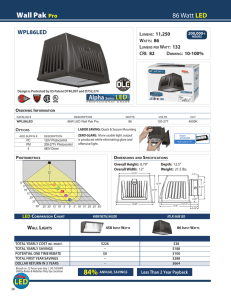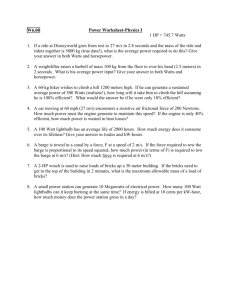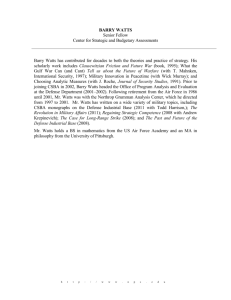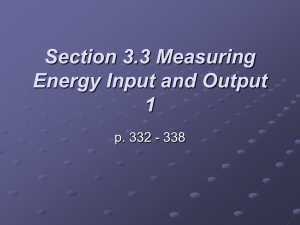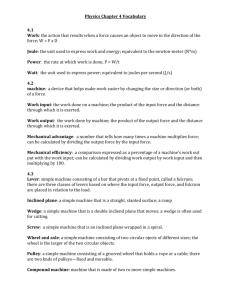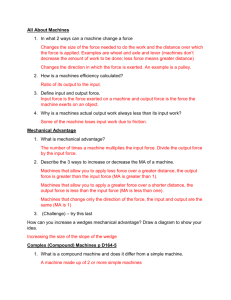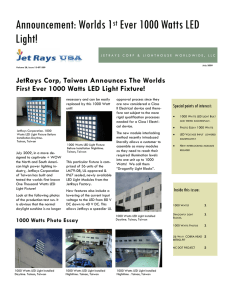Study Guide Chapter 5 Work, Power, and Machines Name: Date
advertisement
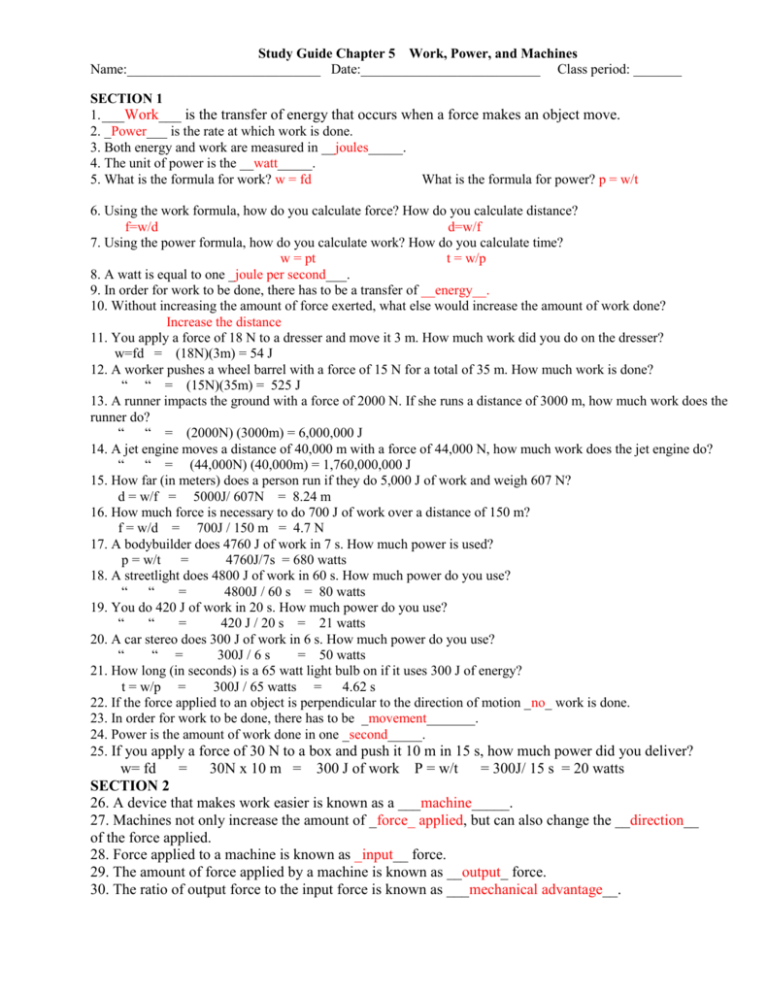
Study Guide Chapter 5 Work, Power, and Machines Name:____________________________ Date:__________________________ Class period: _______ SECTION 1 1. ___Work___ is the transfer of energy that occurs when a force makes an object move. 2. _Power___ is the rate at which work is done. 3. Both energy and work are measured in __joules_____. 4. The unit of power is the __watt_____. 5. What is the formula for work? w = fd What is the formula for power? p = w/t 6. Using the work formula, how do you calculate force? How do you calculate distance? f=w/d d=w/f 7. Using the power formula, how do you calculate work? How do you calculate time? w = pt t = w/p 8. A watt is equal to one _joule per second___. 9. In order for work to be done, there has to be a transfer of __energy__. 10. Without increasing the amount of force exerted, what else would increase the amount of work done? Increase the distance 11. You apply a force of 18 N to a dresser and move it 3 m. How much work did you do on the dresser? w=fd = (18N)(3m) = 54 J 12. A worker pushes a wheel barrel with a force of 15 N for a total of 35 m. How much work is done? “ “ = (15N)(35m) = 525 J 13. A runner impacts the ground with a force of 2000 N. If she runs a distance of 3000 m, how much work does the runner do? “ “ = (2000N) (3000m) = 6,000,000 J 14. A jet engine moves a distance of 40,000 m with a force of 44,000 N, how much work does the jet engine do? “ “ = (44,000N) (40,000m) = 1,760,000,000 J 15. How far (in meters) does a person run if they do 5,000 J of work and weigh 607 N? d = w/f = 5000J/ 607N = 8.24 m 16. How much force is necessary to do 700 J of work over a distance of 150 m? f = w/d = 700J / 150 m = 4.7 N 17. A bodybuilder does 4760 J of work in 7 s. How much power is used? p = w/t = 4760J/7s = 680 watts 18. A streetlight does 4800 J of work in 60 s. How much power do you use? “ “ = 4800J / 60 s = 80 watts 19. You do 420 J of work in 20 s. How much power do you use? “ “ = 420 J / 20 s = 21 watts 20. A car stereo does 300 J of work in 6 s. How much power do you use? “ “ = 300J / 6 s = 50 watts 21. How long (in seconds) is a 65 watt light bulb on if it uses 300 J of energy? t = w/p = 300J / 65 watts = 4.62 s 22. If the force applied to an object is perpendicular to the direction of motion _no_ work is done. 23. In order for work to be done, there has to be _movement_______. 24. Power is the amount of work done in one _second_____. 25. If you apply a force of 30 N to a box and push it 10 m in 15 s, how much power did you deliver? w= fd = 30N x 10 m = 300 J of work P = w/t = 300J/ 15 s = 20 watts SECTION 2 26. A device that makes work easier is known as a ___machine_____. 27. Machines not only increase the amount of _force_ applied, but can also change the __direction__ of the force applied. 28. Force applied to a machine is known as _input__ force. 29. The amount of force applied by a machine is known as __output_ force. 30. The ratio of output force to the input force is known as ___mechanical advantage__. Study Guide Chapter 5 Work, Power, and Machines Name:____________________________ Date:__________________________ Class period: _______ 31. What is the formula for finding MA? output force ÷ input force 32. Define efficiency: measure of how much work is changed into useful output work by a machine 33. What is the formula for calculating efficiency? Work output ÷ work input x 100% 34. If you exert 90 N of force to a machine that delivers 60 N of force, what is the machines efficiency? 60 ÷ 90 = 0.67 x 100% = 67% efficient 35. An inventor claims to have built a machine that can produce 120 J of work with an input of 110 J. Would you believe the inventor's claim? Why or why not? 120 J ÷ 110 J x 100 % = 109% efficient. This is not possible because no machine can be 100% efficient 36. Can a machine ever be 100% efficient? Explain your answer. No, energy is often transferred to another form such as heat and sound. 37. Often times, energy is converted to _heat_ due to __friction__. 38. A __lubricant____ such as oil can be used to increase efficiency of a machine by reducing the amount of friction. SECTION 3 Simple Machines 39. A device that does work with only one movement and changes the size or direction of a force is a(n) _simple_ __machine___. 40. When two or more simple machines work together, they are called a(n)_compound machine _. 41. A winding mountain road is an example of a(n) inclined plane_. 42. An inclined plane with one or two sloping sides forms a machine called a __wedge____. 43. A bar that is free to pivot about a fixed point is called a __lever__. 44. How many of the three different classes of levers can be found in the human body? All three 45. An inclined plane wrapped around a cylindrical post is known as a _screw_____. 46. Grooved wheel with a rope, chain or cable running along a groove is known as a ___pulley___. 47. An arrangement of pulleys designed to reduce the effort force is called a block and tackle_. 48. A pulley that does not move and is mounted to a single point is known as a __fixed_ pulley. 49. A door stop and an axe are both examples of a _wedge___. 50. On the picture of the bicycle below, identify as many simple machines as you can. Screw No inclined planes or wedges Lever wheel and axle
